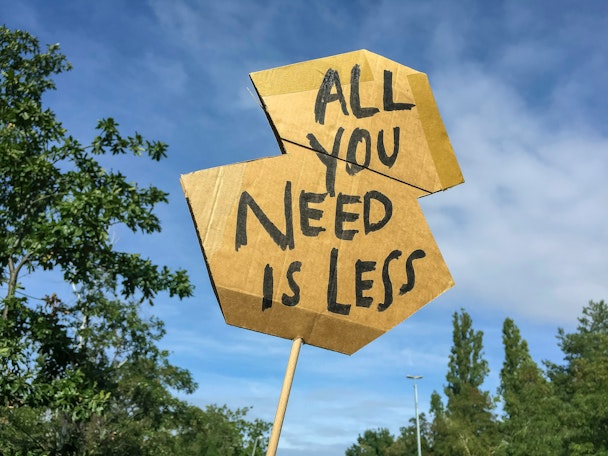Agencies, here’s how to talk to clients about their net zero targets
Those at the coal face of sustainable transformation advise on how to embed sustainability at the core of client relationships.

Agencies and clients should care as much about sustainability as they do creativity / Unsplash
The cultural and regulatory tide is well and truly turning against greenwashing. From the CMA’s investigation into major sectors, including fast fashion and FMCG, to the ASA’s crackdown on companies’ net zero and carbon neutral claims.
Advertising agencies now have a crucial role to play in ensuring brands are backing up their claims with real action to avoid penalization and brand damage in the process.
Advertisement
But the reality is that agencies cannot help clients evolve their sustainability pledges and communications if they don’t have the skills and education themselves – and this needs to be reflected in their own commitments and net-zero strategies.
“Companies like ours shouldn't profess to tell people what to do when we haven’t got our own house in order,” says Julietta Dexter, founder and chief growth and purpose officer of Science Magic.
Advertisement
Agencies need to walk the walk
Ben Essen, global chief strategy officer at Iris said it is seeing more and more long-term AOR briefs where clients “want to be a reference point for sustainability.”
But behind the scenes, he says, those same “CMOs and marketing teams don’t have a deep enough understanding of the science” to make good on the pledges they wish to communicate so it becomes the agency’s job to “straddle the tension between story and substance.”
But for agencies to help clients be seen as an authority on sustainability they need to have their own house in order. Self-awareness and internal education are key for agencies working in this space. Caroline Davison, managing director and sustainability lead at Elvis adds, “if you don’t know if the things your client wants you to say on their behalf are even credible, how are you going to help them transition?”
Suggested newsletters for you
Awareness around reporting and understanding carbon impact will also help agencies in client discussions. She says “there are a lot of very long reports that have so much information in them and if you’re not well versed it can feel overwhelming."
Rigorous vetting can also help agencies determine which clients they choose to work with, and Davison points to the Ad Net Zero six-step guidelines to help assess clients' pledges and credibility when it comes to sustainability commitments and net zero pledges.
However, as awareness of the carbon footprint of agencies and their clients continues to grow, the greatest cause for debate has been whether or not agencies should continue to work with fossil fuels and high-carbon clients such as the automotive and aviation sectors.
Ad Net Zero, the Advertising Association’s network for fighting climate change through advertising, takes the stance that the industry must continue to work with these clients so as to help them evolve into a greener future. “We cannot leave huge swathes of the industry behind,” its chair, Seb Munden, told The Drum.
But Davison suggests agencies wishing to build on Ad Net Zero’s six steps to assessing clients’ pledges and who are concerned with digging deeper might wish to look at Purpose Disruptors' advertising carbon index, which builds on the earlier model of a red, amber and green system that sorts advertisers from the highest carbon emitters to the lowest – helping agencies assess where they might have the most impact, and where they might wish to avoid creating more emissions along the supply chain – “It provides an additional level of integrity and interrogation,” she says.
The broad methodology is available via Purpose Disruptors, the full index itself is expected later this year.
Once agencies have selected their clients, how they work on a brief is changing too, Essen says.
He explains that at Iris, to help clients working across marketing and sustainability “who don’t speak the same language” better understand each other, it now runs green workshops “to get people talking to each other” about the task at hand.
“Seeing it as a two-way innovation process is really important,” as Essen believes that in the coming years, “the idea that you can arrive at sustainability via marketing is really going to be tested,” so agencies will have to take initiative when asking how the client is transforming itself. “What are you doing about it?” is the question that should be on everyone’s lips, because soon enough, companies simply won’t have an option.
“There’s going to be legislation in five minutes,” says Dexter, referring to both the Competition and Market Authority and Advertising Standards Authority’s investigations into green claims – particularly around net zero and carbon neutral claims based on offsetting. “The quicker you can get on the journey, the better, and that’s the language we use with clients.”
But how should agencies handle those clients who make it clear there are limitations on their willingness to change?
“It’s the same dilemma we’ve always faced,” says Essen, “which is the question when a relationship with a client has become untenable.”
Davison says Elvis has started to turn down pitches for clients who weren’t willing to get candid about their long-term sustainability commitments. “It’s a clear red flag for us if, at the beginning of a relationship, they’re not engaged.”
“If it’s an existing client that looks like they just aren’t going to get there, then you need to learn to rely on them less as a client,” she adds. “It’s a difficult decision, because yes, it’s people’s jobs, but we need to be realistic about how high the bar is moving.”
“Some agencies will always have higher thresholds than others,” concludes Essen, “and in the past, these sorts of conversations have always centered around creativity, rather than sustainability, but I think if you swap one out for the other, a lot of the same rules apply.”
“If you’re not having a day-to-day conversation about what amazing creativity looks like, don’t be surprised when you’re not making great work. If you make sustainability the drumbeat of your conversations with clients, then you’re getting somewhere.”

